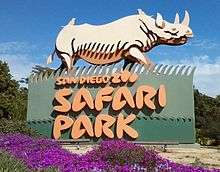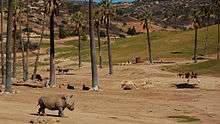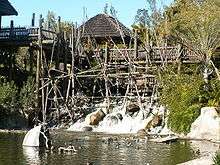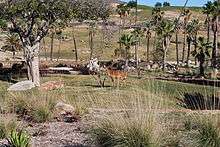San Diego Zoo Safari Park
The San Diego Zoo Safari Park, originally named the San Diego Wild Animal Park until 2010, is an 1,800 acre (730 ha) zoo in the San Pasqual Valley area of San Diego, California, near Escondido. It is one of the largest tourist attractions in San Diego County. The park houses a large array of wild and endangered animals including species from the continents of Africa, Asia, Europe, North and South America, and Australia. The park is in a semi-arid environment, and one of its most notable features is the Africa Tram, which explores the expansive African exhibits. These free-range enclosures house such animals as antelopes, giraffes, buffalo, cranes, and rhinoceros. The park is also noted for its California condor breeding program, the most successful such program in the United States.
 Park entrance sign | |
Entrance to the Park | |
| Date opened | May 10, 1972 |
|---|---|
| Location | City of San Diego Mailing address: Escondido, California 92027[1][2][3] |
| Coordinates | 33.099703°N 117.001525°W |
| Land area | 1,800 acres (7.3 km2) (2.8 sq mi)[4] |
| No. of animals | 3500+[4] |
| No. of species | 400+[4] |
| Memberships | AZA[5] |
| Major exhibits | African Plains, African Outpost, African Woods, Asian Savanna, Condor Ridge, Elephant Valley, Gorilla Forest, Hidden Jungle, Lion Camp, Nairobi Village, Tiger Territory |
| Website | www |
The park, visited by 2 million people annually, houses over 2,600 animals representing more than 300 species, as well as 3,500 plant species.[4]
Depending on the season, the park has about 400 to 600 employees. The park is also Southern California's quarantine center for zoo animals imported into the United States through San Diego.
The park has the world's largest veterinary hospital. Next door to the hospital is the Institute for Conservation Research, which holds the park's Frozen Zoo.
This zoological park and the San Diego Zoo are both run by the Zoological Society of San Diego. The park is 32 miles (51 km) away from the zoo, at 15500 San Pasqual Valley Road, east of Escondido, California, along California State Route 78. Although the park is primarily within the San Diego city limits,[6] it has an Escondido address.[3]
History
The San Diego Zoological Society became interested in developing the Wild Animal Park in 1964. The idea of the park began as a supplementary breeding facility for the San Diego Zoo, which would allow ample space for large animals and ungulates.
The development proposed would differ significantly from that of a typical zoo in that animals would be exhibited in a natural environment rather than in cages. In 1964, the park was assessed financially and then moved onto the next phase; this resulted in three alternative developments. There was an idea for a conservation farm, a game preserve, and a natural environment zoo. The natural environment zoo development was chosen over the conservation farm and game preserve even though it was the most expensive option. The estimated initial cost was $1,755,430.[7]
The main purposes of this zoo were to be species conservation, breeding of animals for the San Diego Zoo as well as other zoos and providing areas where zoo animals could be conditioned. When it came to naming the park, five titles were considered: San Diego Animal Land, San Diego Safari Land, San Diego Wild Animal Safari, San Diego Wildlife Park and San Diego Wild Animal Park.[7]
The scheduled opening day of the park was set for April 1, 1972; however, the gates did not open until May 10, 1972.[7] The general layout of the park, designed by Charles Faust, included a large lagoon with a jungle plaza, an African fishing village, an aviary at the entrance of the park and approximately 50,000 plants were to be included in the landscaping.[7] Although the park was scheduled to open in three years from the time of the groundbreaking, the total development of the park was estimated to take ten years.
The first two animals to arrive at the park were the nilgai, an antelope from the plains of North India, and the black-and-white striped Grant's zebra, native to East Africa.[7] Other animals to arrive at the park include the gemsbok, a type of oryx from South Africa and Namibia, the sable antelope, the greater kudu, the white rhinoceros which was in danger of extinction, the Indian rhinoceros, , & 10 cheetahs, who were brought to the park for breeding purposes.
In the summer of 2003, the San Diego Zoological Society and Lowry Park Zoo orchestrated the capture of 11 wild African elephants from the Hlane Royal National Park in Swaziland. The zoos said the animals were scheduled to be killed due to overpopulation.[8] However, In Defense of Animals disputes this, claiming that new fencing costing many times less than the capture and transport would have ended the need to remove any elephants from Swaziland, and that the Save Wild Elephants Coalition reported that there were three other sanctuaries in Africa that had offered to take the elephants.[9]
Five of these elephants are now at the San Diego Zoo Safari Park,[8] and cumulatively they have produced thirteen babies as of 2013.[10][11] In March 2012 five elephants were moved to the Reid Park Zoo in Tucson, Arizona, to form a new herd. A bull elephant, two cows, and two baby bulls were moved and in return two cow elephants that had been together for years. Connie, an Asian elephant, and Shaba, an African elephant, were sent to the San Diego Zoo.[12][13] Connie died from cancer in July 2012 just five months after the move. Shaba was slowly introduced into the herd in February 2013.[14]
The California wildfires that officially started on October 21, 2007, burned 600 acres (2.4 km2) of native habitat preserved in the park and caused it to temporarily close. The park also moved many of their endangered animals out of danger. The fire did not reach any of the main enclosures, and no animals were killed directly by the fire, although deaths of a clapper rail and kiang were attributed to indirect effects of the blaze.
On June 30, 2010 the San Diego Zoo board of trustees voted to change the name of the park from the Wild Animal Park to the San Diego Zoo Safari Park to clarify what it offers, since some visitors were unclear as to the difference between the zoo proper and the "animal park". The name "safari" is supposed to emphasize "the park's spacious enclosures of free-ranging animals" (as opposed to "the closer quarters of the zoo"), encouraging visits to both locations.[15]

Exhibits and attractions
Asian Savanna and African Plains

The park's largest exhibits, covering over 300 acres (120 ha),[16] are the open-range enclosures. Visitors view various plains habitats from Africa and Asia. Asian Savanna covers 60 acres (24 ha) and displays Indian rhinoceros, Bactrian camels, banteng, gaur, argali, mouflon, dholes, Sarus cranes, and several species of Asian deer and antelope such as blackbuck, barasingha, sika deer, axis deer, Eld's deer, Père David's deer, nilgai, hog deer, white-lipped deer, sambar, and wapiti.[16] African Plains represents many regions and habitats. East Africa displays cape buffalo, southern white rhinoceros, Rothschild's giraffe, reticulated giraffe, beisa, fringe-eared oryx, waterbuck, Nile lechwe, red lechwe, impala, Grant's gazelle, Thomson's gazelle, and a lagoon with East African crowned cranes, Dalmatian pelicans, Sacred ibises & Great white pelicans.[16] The North Africa exhibit represents the Sahel and Sahara that houses scimitar-horned oryx, barbary stag, red-fronted gazelle, Barbary sheep and Ankole-Watusi cattle.[16] The Southern Africa field exhibits Grévy's zebras. The South Africa field exhibit holds Masai giraffes, common eland, sable antelope, gemsbok, springbok, blue wildebeest, blesbok, & ostrich.[17] The Central Africa region features a wooded waterhole with an island for pink-backed pelicans, saddle-billed storks, Lappet-faced vultures, Spur-winged geese, Goliath herons, and Rüppell's vultures. On the shores of the lake are bongo antelope, red river hog, greater kudu, Ugandan kob, grey rhebok, roan antelope, and other forest animals.[17] A number of smaller enclosures visible only from the tram are home to Somali wild ass, Nubian ibex, kiangs, Arabian oryx, bharal, gorals, Japanese serows, markhor, Soemmerring's gazelles, black rhinoceroses, Slender-horned gazelles, and Przewalski's horses.

Species of note in the open enclosures include two subspecies of giraffe, rhinos (it was the last New World zoo to have northern white rhinoceros), gaur, vultures, markhor, and many species of antelope, gazelle, and deer.
Tiger Trail
The Sumatran tigers have three different exhibits, and there is a glass viewing window for visitors.[18][19] After raising $19.6 million for the new exhibit ground was broken on December 12, 2012. The new exhibit is named the Tull Family Tiger Trail after movie producer Thomas Tull and his wife.[20] Tiger Trail opened May 24, 2014.
Nairobi Village and Gorilla Forest
The park's Nairobi Village houses numerous exhibits for smaller animals. Among these are meerkats, an African aviary, ring-tailed lemurs, Chilean flamingos, pudú, dik-dik antelopes, Yellow-backed duikers, red river hogs, West African crowned cranes, coatis, and white-fronted bee-eaters.[21] A large lagoon is home to numerous species of waterfowl, both foreign & native, as well as shoebill storks.[21] Lorikeet Landing and Hidden Jungle display feedable lories and lorikeets, and African birds, respectively. There is a nursery where visitors can watch baby animals being hand-reared as well as a nearby petting corral.[21] Finally, a gorilla habitat houses a troop of western lowland gorillas. A flying fox bat exhibit also located there.
Hidden Jungle
Located in Nairobi Village, this climate-controlled indoor exhibit opened in 1993 and displays tropical African birds and insects. The entrance to the building is a simulated earthen crevasse with displays for stick insects, spiders, scorpions, insects, millipedes, lizards, & snakes. The underground segment opens up to a room representing the rainforest understory, which leads to a second room representing the canopy. On display are long-tailed paradise whydah, purple grenadier, red-crested turaco, African pygmy goose, beautiful sunbird and other birds.
Hidden Jungle is the setting of the annual Butterfly Jungle event.
Lion Camp
Opened in October 2004, Lion camp houses the park's thirteen African lions in a 1-acre (0.40 ha) exhibit.[24] One side of the enclosure is dominated by an artificial rock kopje which has a 40-foot-long (12 m) glass viewing window and heated rocks.[24] The path continues along an acacia-studded ravine and leads to a replica observation tent. This has a smaller viewing window as well as a Land Rover for the lions to rest on.
Condor Ridge
Condor Ridge displays endangered North American desert wildlife.[25] The featured species are California condors[25] (the Wild Animal Park was the key force in the recovery effort for these birds and this is one of the only places in the world where the public can see them in captivity) and desert bighorn sheep.[25] Other species displayed include aplomado falcons, loggerhead shrikes, thick-billed parrots, Northern Bald eagles, prairie dogs, black footed ferrets, magpies, ocelots, porcupines, Harris's hawks, and desert tortoises.[25]
African Woods and African Outpost
Formerly known as Heart of Africa, these are two of the park's major exhibits. Visitors go down a trail which replicates habitats in Africa. The exhibit begins in African Woods with scrub animals - bontebok, vultures such as the Egyptian vulture & the hooded vulture, and giant eland. It then progresses to the forest (okapi, duikers, red river hogs, gerenuk, steenbok, blue cranes, demoiselle cranes, wattled cranes, and Abdim's storks). The path then leads to African Outpost, which features plains animals - warthogs, bat eared foxes, ground hornbills, kori bustards, secretary birds, white storks, yellow-billed storks, cheetahs & nyalas - against a backdrop of the open-range East Africa exhibit. A central lagoon has lesser and greater flamingos, waterfowl, sitatunga, an island with black-and-white colobus monkeys, and an interpretive research camp on a separate island.

Tours and rides
The park formerly operated a monorail line, the Wgasa Bush Line, which ran clockwise through the Wild Animal Park. The name of the monorail was chosen by chief designer Chuck Faust.
The Monorail line has been retired, partially due to high maintenance costs, and in March 2007 the Journey into Africa attraction, now renamed Africa Tram, opened. The Africa Tram tour runs counterclockwise and brings visitors to the field exhibits to see wildlife from different parts of Africa. In addition, another route is planned to bring visitors through the Asian field exhibits and into eight new ones that will house a variety of African animals from rock hyrax to Hartmann's mountain zebras. The tour utilizes a wheeled tram that runs on biofuel instead of a monorail.
As well as the tram, the park has also added a tethered balloon ride that allows visitors to see the plains exhibits from 400 feet (120 m) (~21 giraffes) in the air.[26] The balloon ride is not included in the entrance fee.
Gardens
The park also has extensive botanical gardens, many of which are their own attractions separate from the animal exhibits.
Walkabout Australia
Walkabout Australia is the park's only Australia exhibit.[27] It is 3.6 acres and guests can go inside an exhibit which features western grey kangaroos, red necked wallabies, Australian brushturkeys, radjah ducks, freckled ducks and magpie geese. Walkabout Australia also has two southern cassowary exhibits, a Matschie's tree-kangaroo exhibit and an animal ambassador area where guests can meet the safari park's Australian animal ambassadors. Walkabout Australia also has a restaurant and a devils marbles area. Walkabout Australia is included with zoo admission and a new exhibit called Platypus Pond is home to two platypuses. The exhibit opened in 2019.
Conservation
The Safari Park was a major factor in the recovery of the California condor. Beginning in 1980, it worked with the U.S. Fish and Wildlife Service and the Los Angeles Zoo to start a captive breeding program.[28] The last 22 condors were taken into captivity in 1987[28] To breed the condors quickly, the Safari Park would remove the eggs from the nests to induce the females to lay a second egg.[28][29] The removed egg hatches in an incubator and is raised with a condor handpuppet to prevent human imprinting, while the second egg is raised by its parents.[28][29] Captive-bred condors were reintroduced into the wild beginning in 1992, and today their population is 369, with 191 in the wild as of March 2011.[28]
On December 14, 2014, Angalifu, a 44-year-old male northern white rhinoceros, died of old age at the park. This left only five northern white rhinos left in the world, including one female at the Safari Park.[30] On November 22, 2015, the park's last Northern White Rhino, 41-year old Nola was euthanized due to bacterial infection and her health rapidly failing.
In June 2019, two young male African elephants named Ingadze and Lutsandvo were sent to Alabama's Birmingham Zoo as part of the Association of Zoos and Aquariums' Species Survival Plan.[31]
Awards
The Safari Park has received several awards for its breeding programs and conservation efforts.
| Year | Awarding body | Award | Notes |
|---|---|---|---|
| 1972 | American Association of Zoological Parks and Aquariums (AAZPA) | Edward H. Bean Award | For hatching of Abyssinian ground hornbill[32] |
| 1974 | AAZPA | Edward H. Bean Award | For hatching of Abyssinian ground hornbill[32][33] |
| 1989 | AAZPA | Edward H. Bean Award | For California condor breeding (shared with San Diego Zoo and Los Angeles Zoo)[32][33] |
| 1994 | Association of Zoos and Aquariums (AZA) | Significant Achievement Award | For hornbill breeding program[32] |
| 2007 | Avian Scientific Advisory Group (ASAG) | Plume Award for Noteworthy Achievement in Avian Husbandry | For the Light-footed Clapper Rail coalition [shared with Chula Vista Nature Center, SeaWorld San Diego, San Diego Zoo, and United States Fish and Wildlife Service (USFWS) Reserve][34] |
| 2011 | USFWS | Endangered Species Recovery Champion Award (Pacific Southwest Region) | Awarded to Michael Mace, Curator of Birds, for work with California condors and light-footed clapper rails[32] |
Notes
- http://www.sandiego.org/listing/Visitors/2985
- http://sdzsafaripark.org/visitor-info/hours-and-directions
- http://www.sandiegomagazine.com/calendar/index.php/name/Summer-Safari/event/16913/
- "About the San Diego Zoo". sandiegozoo.org. San Diego Zoo. Archived from the original on 6 December 2010. Retrieved 6 June 2012.
- "Currently Accredited Zoos and Aquariums". aza.org. AZA. Retrieved May 28, 2014.
- "San Pasqual Valley Plan" (PDF). City of San Diego Planning Department. p. 29. Retrieved February 6, 2012.
Most commercial activity in the San Pasqual Valley is related to tourism, education or recreation. These uses include ... the San Diego Wild Animal Park operated by the zoological society on 1,800 acres of land leased from the City
- Article: San Diego Wild Animal Park, by Sandy Harriger; http://history.sandiego.edu/GEN/USPics/zoo/wildanimalpark3.html
- Shroder, Susan. "African elephant born at San Diego Wild Animal Park". sandiegouniontribune.com. Retrieved 2018-11-05.
- {{<-In Defense of Animals->|archiveurl=https://web.archive.org/web/20040815010834/http://www.idausa.org/campaigns/elephants/falseclaims.htm|archivedate=2002-11-28|accessdate=2015-03-12|url-status=dead}}
- "Travel - Los Angeles Times". latimes.com. Retrieved 2018-11-05.
- "Meet the Herd". San Diego Zoological Association. Archived from the original on 4 April 2013. Retrieved 20 March 2013.
- "Welcome elephants Connie and Shaba". blogs.sandiegozoo.org. Archived from the original on 2 October 2013. Retrieved 20 March 2013.
- Lori Weisberg (March 2, 2012). "Elephant pals at home in SD Zoo". The San Diego Union-Tribune. Retrieved 22 June 2018.
- "Elephant Shaba meets the girls". blogs.sandiegozoo.org. Retrieved 20 March 2013.
- Brennan, Deborah Sullivan (12 July 2010). "Wild Animal Park to switch to 'Safari Park'". North County Times. Archived from the original on 15 July 2010. Retrieved 13 July 2010.
- "Wild Animal Park Exhibit: Asia and Africa Field Exhibits". sandiegozoo.org. Zoological Society of San Diego. Archived from the original on 24 August 2006.
- "Wild Animal Park Exhibit: Journey into Africa Tour". sandiegozoo.org. Zoological Society of San Diego. Archived from the original on 24 August 2007.
- "Tiger Trail at the San Diego Zoo Safari Park". www.sdzsafaripark.org. Retrieved 2018-11-05.
- "Tigers at the Park: Please Help Build Their New Home". sandiegozoo.org. Zoological Society of San Diego. 30 December 2011.
- "San Diego Safari Park breaks ground on 5 acre tiger habitat". kpbs.org. Retrieved 20 March 2013.
- "Wild Animal Park: Nairobi Village". sandiegozoo.org. Zoological Society of San Diego. 12 August 2006. Archived from the original on August 12, 2006.
- "Wild Animal Park: Lion Camp". sandiegozoo.org. San Diego Zoological Society. Archived from the original on 7 February 2005.
- "Condor Ridge at the Wild Animal Park Exhibit Description". sandiegozoo.org. Zoological Society of San Diego. Archived from the original on 6 March 2005.
- "San Diego Zoo Safari Park: Activities". sandiegozoo.org. San Diego Zoological Society. Retrieved 12 October 2011.
- Bradley J. Fikes (May 23, 2018). "Kangaroos, kookaburras and echidnas, oh my! Walkabout Australia opens at San Diego Zoo Safari Park". The San Diego Union-Tribune. Retrieved June 17, 2018.
- "California Condor Recovery". azgfd.gov. Arizona Game and Fish Department. Archived from the original on 29 April 2011.
- "SDZ Global Wildlife Conservancy - Success Stories - Condors". sandiegozooglobal.org. Zoological Society of San Diego. 30 December 2011. Archived from the original on 2011-09-25.
- "Death of Rare White Rhino Leaves 5 in the World". National Geographic. December 16, 2014. Retrieved 18 December 2014.
- https://timesofsandiego.com/life/2019/06/28/birmingham-zoo-welcomes-2-new-male-african-elephants-from-san-diego-zoo-safari-park/
- "SDZG History Timeline". San Diego Zoo Global. Retrieved 2015-05-27.
- "Edward H. Bean Award". aza.org. Association of Zoos and Aquariums. Archived from the original on 2015-06-22. Retrieved 2015-06-01.
- "Past Plume Awards Recipients". aviansag.org. Avian Scientific Advisory Group. Retrieved 2015-06-21.
References
- Myers, Douglas (1999). Mister Zoo: The Life and Legacy of Dr. Charles Schroeder: The World-Famous San Diego Zoo and Wild Animal Park's Legendary Director. The Zoological Society of San Diego. ISBN 0-911461-15-9.
External links
| Wikimedia Commons has media related to San Diego Zoo Safari Park. |